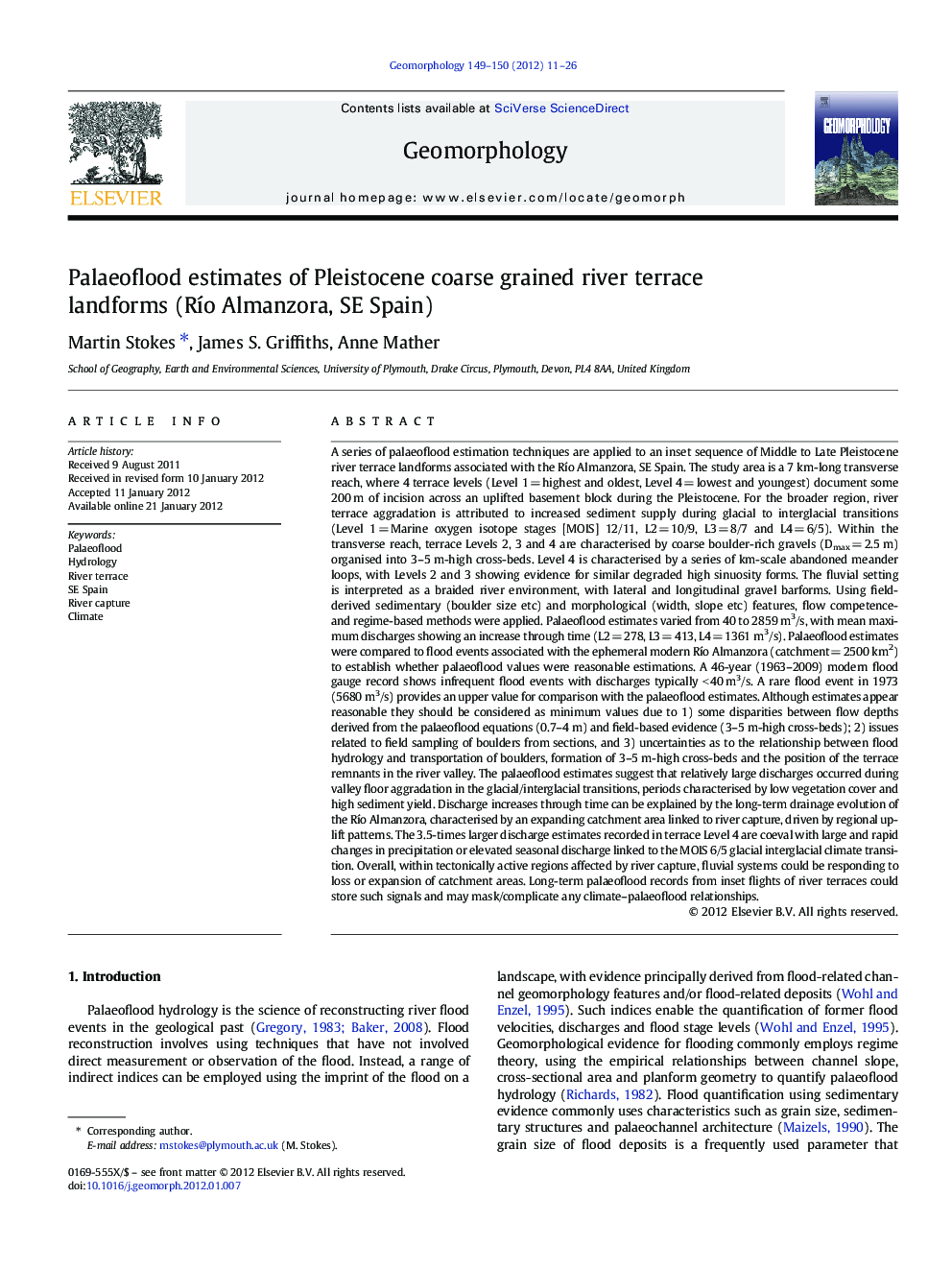| کد مقاله | کد نشریه | سال انتشار | مقاله انگلیسی | نسخه تمام متن |
|---|---|---|---|---|
| 4685207 | 1635484 | 2012 | 16 صفحه PDF | دانلود رایگان |

A series of palaeoflood estimation techniques are applied to an inset sequence of Middle to Late Pleistocene river terrace landforms associated with the Río Almanzora, SE Spain. The study area is a 7 km-long transverse reach, where 4 terrace levels (Level 1 = highest and oldest, Level 4 = lowest and youngest) document some 200 m of incision across an uplifted basement block during the Pleistocene. For the broader region, river terrace aggradation is attributed to increased sediment supply during glacial to interglacial transitions (Level 1 = Marine oxygen isotope stages [MOIS] 12/11, L2 = 10/9, L3 = 8/7 and L4 = 6/5). Within the transverse reach, terrace Levels 2, 3 and 4 are characterised by coarse boulder-rich gravels (Dmax = 2.5 m) organised into 3–5 m-high cross-beds. Level 4 is characterised by a series of km-scale abandoned meander loops, with Levels 2 and 3 showing evidence for similar degraded high sinuosity forms. The fluvial setting is interpreted as a braided river environment, with lateral and longitudinal gravel barforms. Using field-derived sedimentary (boulder size etc) and morphological (width, slope etc) features, flow competence- and regime-based methods were applied. Palaeoflood estimates varied from 40 to 2859 m3/s, with mean maximum discharges showing an increase through time (L2 = 278, L3 = 413, L4 = 1361 m3/s). Palaeoflood estimates were compared to flood events associated with the ephemeral modern Río Almanzora (catchment = 2500 km2) to establish whether palaeoflood values were reasonable estimations. A 46-year (1963–2009) modern flood gauge record shows infrequent flood events with discharges typically < 40 m3/s. A rare flood event in 1973 (5680 m3/s) provides an upper value for comparison with the palaeoflood estimates. Although estimates appear reasonable they should be considered as minimum values due to 1) some disparities between flow depths derived from the palaeoflood equations (0.7–4 m) and field-based evidence (3–5 m-high cross-beds); 2) issues related to field sampling of boulders from sections, and 3) uncertainties as to the relationship between flood hydrology and transportation of boulders, formation of 3–5 m-high cross-beds and the position of the terrace remnants in the river valley. The palaeoflood estimates suggest that relatively large discharges occurred during valley floor aggradation in the glacial/interglacial transitions, periods characterised by low vegetation cover and high sediment yield. Discharge increases through time can be explained by the long-term drainage evolution of the Río Almanzora, characterised by an expanding catchment area linked to river capture, driven by regional uplift patterns. The 3.5-times larger discharge estimates recorded in terrace Level 4 are coeval with large and rapid changes in precipitation or elevated seasonal discharge linked to the MOIS 6/5 glacial interglacial climate transition. Overall, within tectonically active regions affected by river capture, fluvial systems could be responding to loss or expansion of catchment areas. Long-term palaeoflood records from inset flights of river terraces could store such signals and may mask/complicate any climate–palaeoflood relationships.
► Competence and regime palaeoflood methods are applied to river terrace sediments.
► Palaeoflood discharge estimates are compared to a 42 year modern flood gauge record.
► Palaeoflood discharge estimates are higher than the modern flood discharge values.
► Palaeoflood discharges increase over time, notably during the Late Pleistocene.
► Pleistocene climate variability and river capture explain the discharge patterns.
Journal: Geomorphology - Volumes 149–150, 1 May 2012, Pages 11–26